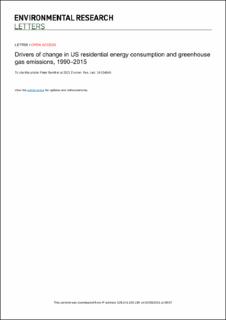| dc.contributor.author | Berrill, Peter | |
| dc.contributor.author | Gillingham, Kenneth T. | |
| dc.contributor.author | Hertwich, Edgar G. | |
| dc.date.accessioned | 2021-11-04T11:33:47Z | |
| dc.date.available | 2021-11-04T11:33:47Z | |
| dc.date.created | 2021-05-18T12:19:27Z | |
| dc.date.issued | 2021 | |
| dc.identifier.citation | Environmental Research Letters. 2021, 16 (3), . | en_US |
| dc.identifier.issn | 1748-9326 | |
| dc.identifier.uri | https://hdl.handle.net/11250/2827845 | |
| dc.description.abstract | Annual greenhouse gas (GHG) emissions from residential energy use in the United States peaked in 2005 at 1.26 Gt CO2-eq yr−1, and have since decreased at an average annual rate of 2% yr−1 to 0.96 Gt CO2-eq yr−1 in 2019. In this article we decompose changes in US residential energy supply and GHG emissions over the period 1990–2015 into relevant drivers for four end-use categories. The chosen drivers encompass changing demographics, housing characteristics, energy end-use intensities, and generation efficiency and GHG intensity of electricity. Reductions in household size, growth in heated floor area per house, and increased access to space cooling are the main drivers of increases in energy and GHG emissions after population growth. Growing shares of newer homes, and reductions in intensity of energy use per capita, household, or floor area have produced moderate primary energy and GHG emission reductions, but improved generation efficiency and decarbonization of electricity supply have brought about far bigger primary energy and GHG emission reductions. Continued decline of residential emissions from electrification of residential energy and decarbonization of electricity supply can be expected, but not fast enough to limit climate change to 1.5 °C warming. US residential final energy demand will therefore need to decline in absolute terms to meet such a target. However, without changes in the age distribution, type mix, or average size of housing, improvements in energy efficiency are unlikely to outweigh growth in the number of households from population growth and further household size reductions. | en_US |
| dc.language.iso | eng | en_US |
| dc.publisher | IOP Publishing | en_US |
| dc.relation.uri | https://iopscience.iop.org/article/10.1088/1748-9326/abe325 | |
| dc.rights | Navngivelse 4.0 Internasjonal | * |
| dc.rights.uri | http://creativecommons.org/licenses/by/4.0/deed.no | * |
| dc.title | Drivers of change in US residential energy consumption and greenhouse gas emissions, 1990-2015 | en_US |
| dc.type | Peer reviewed | en_US |
| dc.type | Journal article | en_US |
| dc.description.version | publishedVersion | en_US |
| dc.source.pagenumber | 12 | en_US |
| dc.source.volume | 16 | en_US |
| dc.source.journal | Environmental Research Letters | en_US |
| dc.source.issue | 3 | en_US |
| dc.identifier.doi | 10.1088/1748-9326/abe325 | |
| dc.identifier.cristin | 1910468 | |
| cristin.ispublished | true | |
| cristin.fulltext | original | |
| cristin.qualitycode | 2 | |

